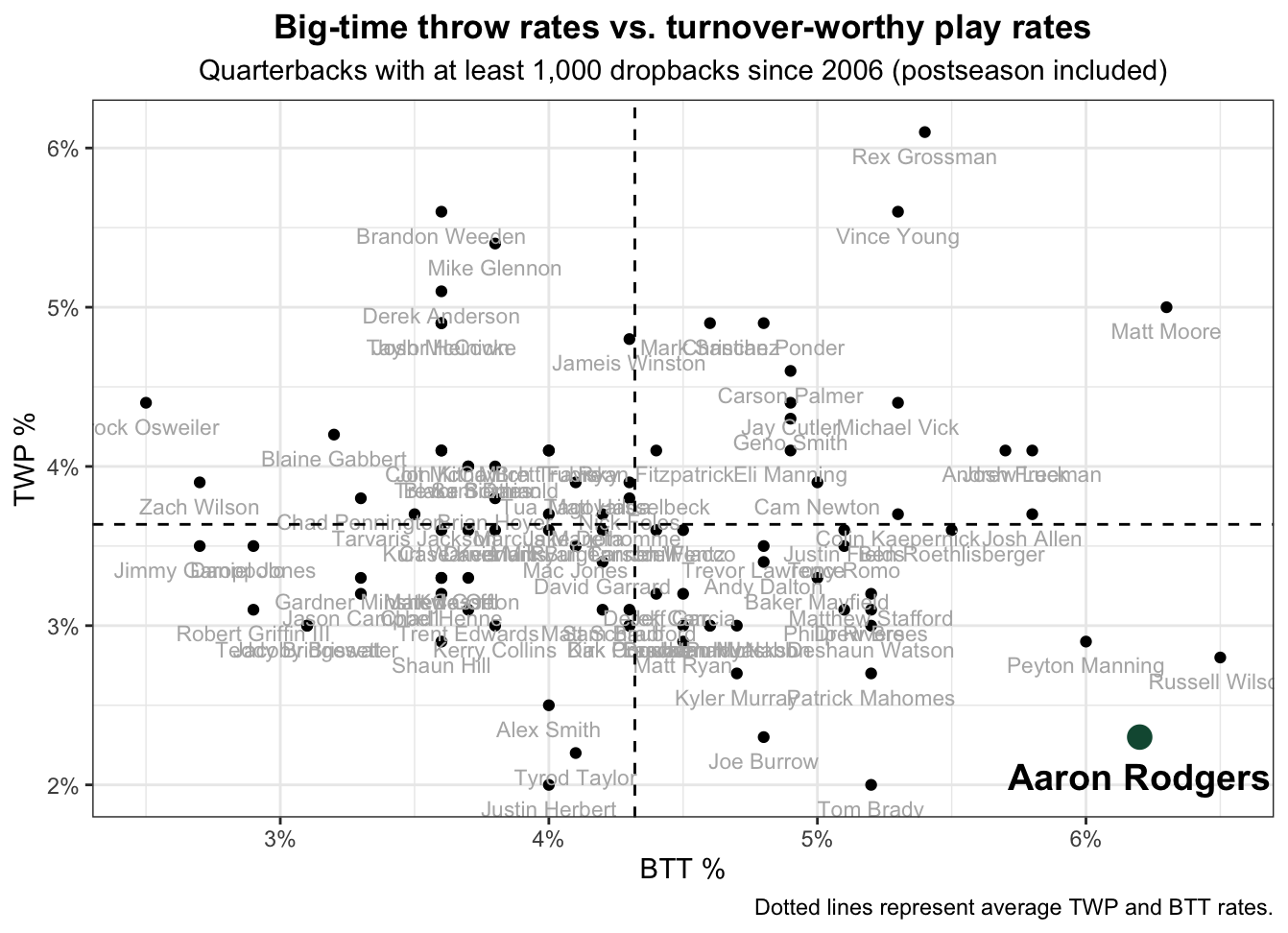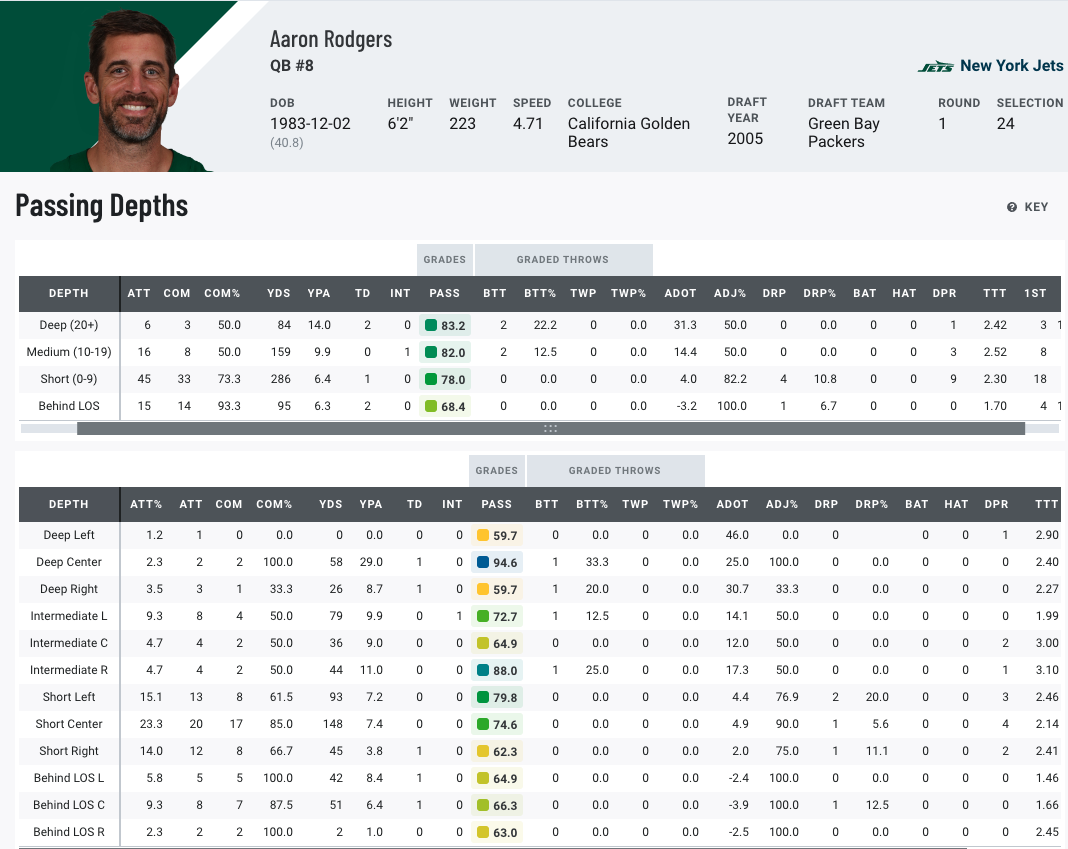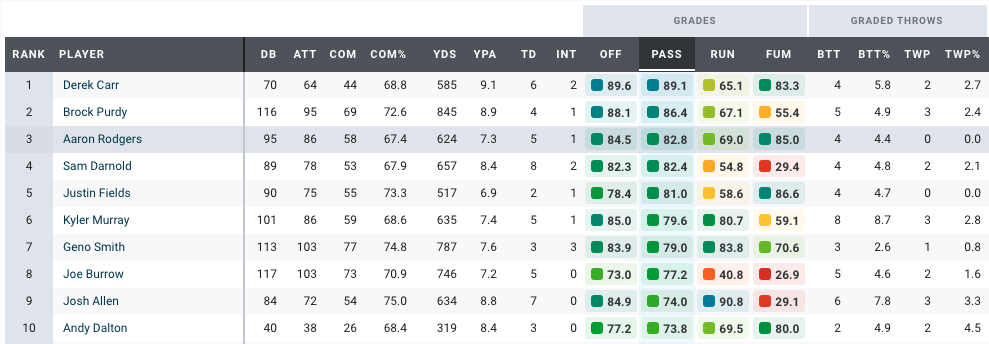• He’s back: Through three weeks, Aaron Rodgers holds the third-best passing grade in the league. He has been the Jets’ best player, guiding them through a grueling stretch of three games in just 11 days.

• A master of his craft: This season, Rodgers has earned a 76.5 passing grade against the blitz, shaking off the rust quickly after his time off. In Week 3, New England employed a blitz-heavy approach, sending extra pressure on 40% of his dropbacks. Rodgers responded by completing 11 of his 15 passes against the blitz and posting an 86.7 passing grade.
When the New York Jets traded for Aaron Rodgers, they may not have expected him to return to his MVP form from 2020 or 2021, but they were confident they were acquiring a reliable, competent passer. Rodgers had shown he still had plenty left in the tank to lead the Jets to success, even though his dip in production during the 2022 season saw him finish 10th in the NFL in passing grade.
Eighteen months, one torn Achilles, and three starts later, Rodgers is proving he’s still one of the NFL’s elite passers. Through three weeks, he holds the third-best passing grade in the league. Rodgers has been the Jets’ best player, guiding them through a grueling stretch of three games in just 11 days.
Nearly any passing metric highlights the improvement Rodgers brings to the Jets, but a few specific ones set him apart from both his predecessors and the rest of the NFL.

Rodgers is one of the greatest risk mitigators in NFL history, and that trend has continued in New York. He’s currently one of just three qualified quarterbacks in the league to have committed zero turnover-worthy plays through the first three weeks of the season. In fact, he’s the first Jets quarterback in PFF history to go three consecutive regular-season games without a turnover-worthy play.
Rodgers’ ability to minimize highly negative plays has significantly improved New York’s offense, especially compared to the quarterback play of recent years. However, his impact goes beyond risk reduction; it’s also about his unique mastery of processing defenses.
One standout element is the speed at which Rodgers reads defenses and delivers the ball to the right target. He currently has the third-fastest average time to throw in the NFL at 2.48 seconds. While some quarterbacks may get rid of the ball quickly in a conservative manner, that’s not the case with Rodgers. His rapid decision-making is both precise and aggressive.

The veteran quarterback has recorded the ninth-highest average depth of target on throws released in under 2.5 seconds, yet he leads the NFL with an 88.7 passing grade in those scenarios. Additionally, he’s the only quarterback with three big-time throws released in under 2.5 seconds. Not only is he quickly diagnosing defenses, but he’s also finding ways to attack them downfield.
The Jets have also revamped their offensive line to protect their 40-year-old quarterback, who’s recovering from a torn Achilles. While the unit is still developing cohesion, defenses are trying to apply extra pressure when possible. Rodgers, however, has an exceptional understanding of where blitzes are coming from and how to counter them.
This season, Rodgers has earned a 76.5 passing grade against the blitz, shaking off the rust quickly after his time off. In Week 3, New England employed a blitz-heavy approach, sending extra pressure on 40% of his dropbacks. Rodgers responded by completing 11 of his 15 passes against the blitz and posting an 86.7 passing grade.
Aaron Rodgers: Pressured passing report

Along with recognizing pressure, Rodgers remains a savant at reading coverages and understanding how secondaries are trying to disrupt his offense. He sees everything on the field — from coverage schemes and defender depth to subtle false steps that cause defenders to lose leverage on receivers.
Performance against specific defensive schemes is one of the easier things to quantify. Lately, there’s been a lot of discussion around how two-high safety coverages are stifling quarterback production, but Rodgers appears to have found the solution to that problem.
Rodgers has dropped back 41 times against two-high safety coverages this season, posting a league-best 90.4 passing grade in those situations. He also owns the third-lowest average depth of target against these coverages.

While he takes deep shots when they’re available, Rodgers excels at taking what the defense gives him, making him the best quarterback in the league in that regard right now. Too many quarterbacks force throws into coverages designed to prevent deep shots, but Rodgers is content to move the chains until opportunities for explosive plays arise naturally.
Though Rodgers may not be as physically dominant as he once was, he moved well against New England in Week 3, and his greatest asset remains his mind. His unmatched ability to process everything happening on the field is what sets him apart in today’s NFL.
That mastery, combined with the Jets’ talented offensive weapons, has the potential to elevate the team’s offense to heights it has rarely experienced.














